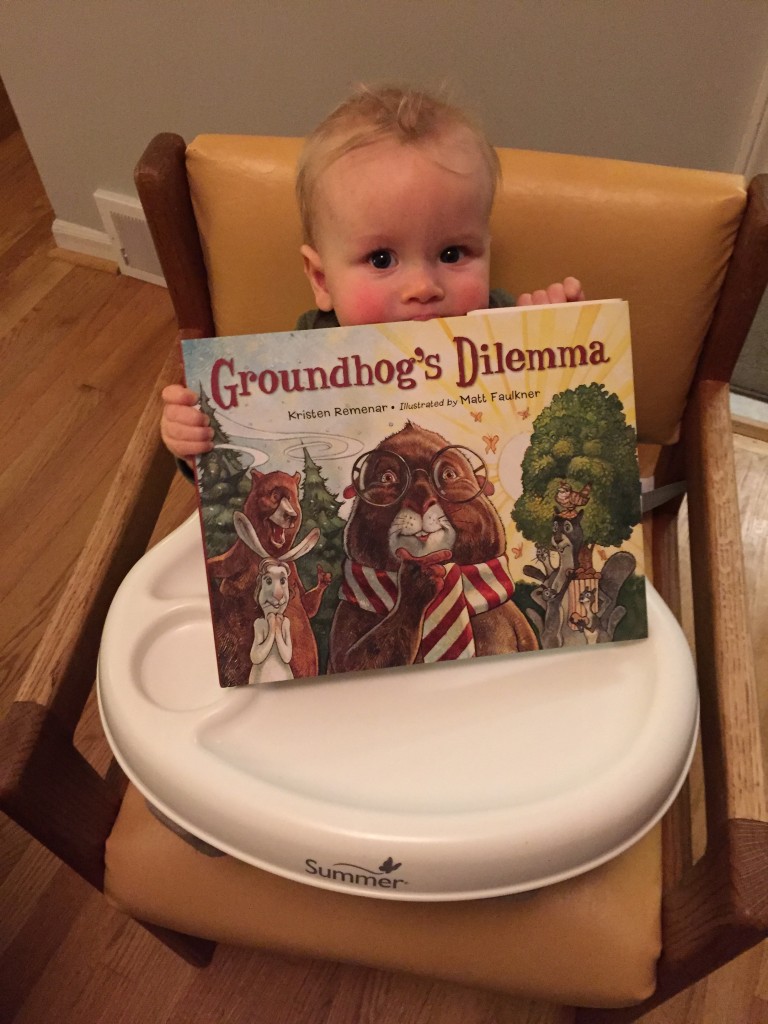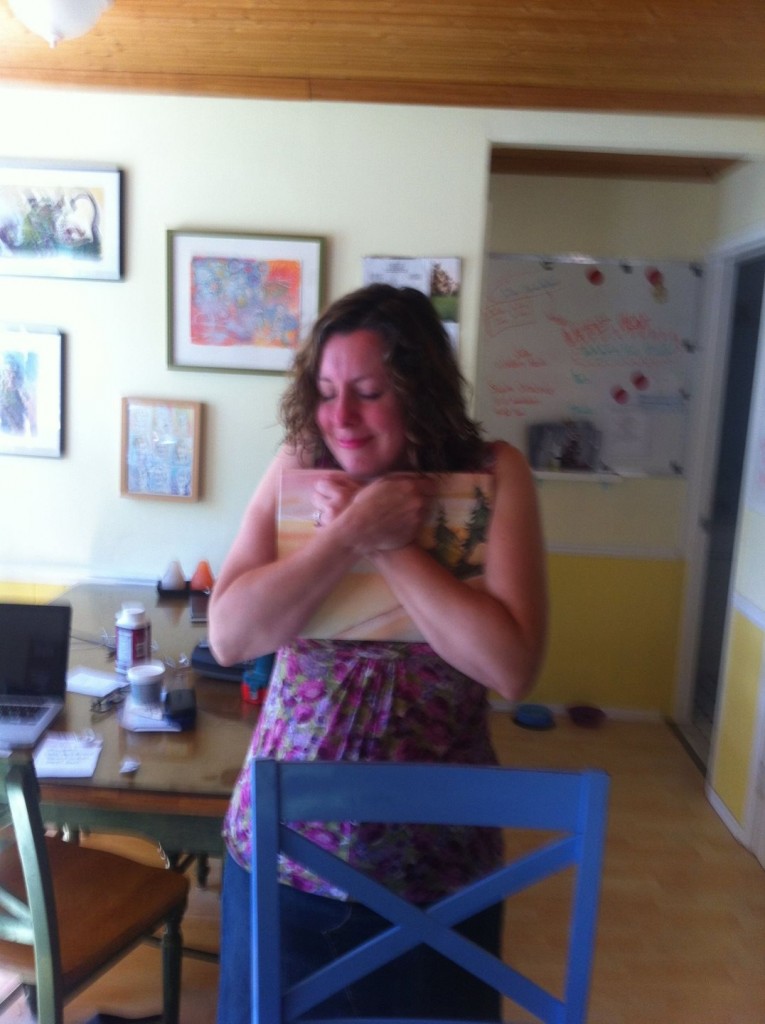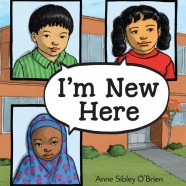SQUIRREL NEEDS A BREAK!
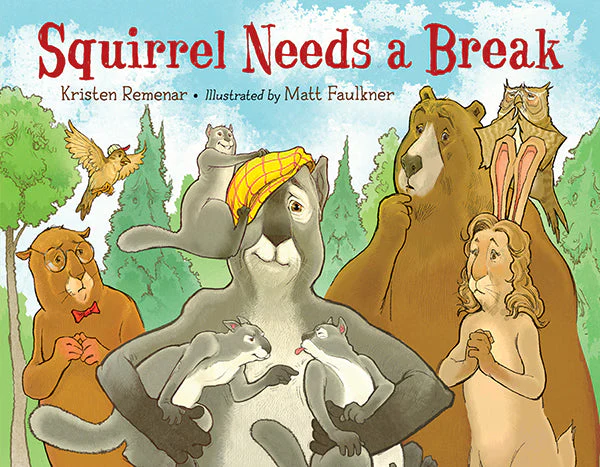
I’m thrilled to announce that my newest picture book, SQUIRREL NEEDS A BREAK, will be published by Charlesbridge on May 7th! Squirrel is especially grumpy after having been stuck in the nest all winter with three rascally kits so his friends decide to take the kits for the day to give him a break – how hard could it be, they think? By the end of a very busy day, Groundhog and his friends have a whole new appreciation for what Squirrel does as a single parent, and Squirrel realizes that he has family he can rely upon in his circle of friends. It’s a great book for fathers, single parents, and anyone who knows what a handful little kits can be!
Matt Faulkner and I will be visiting some local bookstores and libraries. I hope to see you there!
May 11th: 2 Dandelions Bookshop in Brighton, MI at 11am
May 18th: Sidetrack Bookshop in Royal Oak, MI at 11 am
May 19th: The Book Beat in Oak Park, MI at 2 pm
May 25th: Schuler Books in West Bloomfield, MI at 11 am
June 1st: Orion Township Public Library in Lake Orion, MI at 11 am
June 8th: Eras Bookstore in Oxford, MI at 11 am
Read MoreSQUIRREL NEEDS A BREAK!
See these cuties from GROUNDHOG’S DILEMMA? Well, they get to be the stars of their very own companion book! SQUIRREL NEEDS A BREAK, written by me and illustrated by the wonderful Matt Faulkner will by published by Charlesbridge in Spring of 2024! Watch this space for more updates. Hooray!
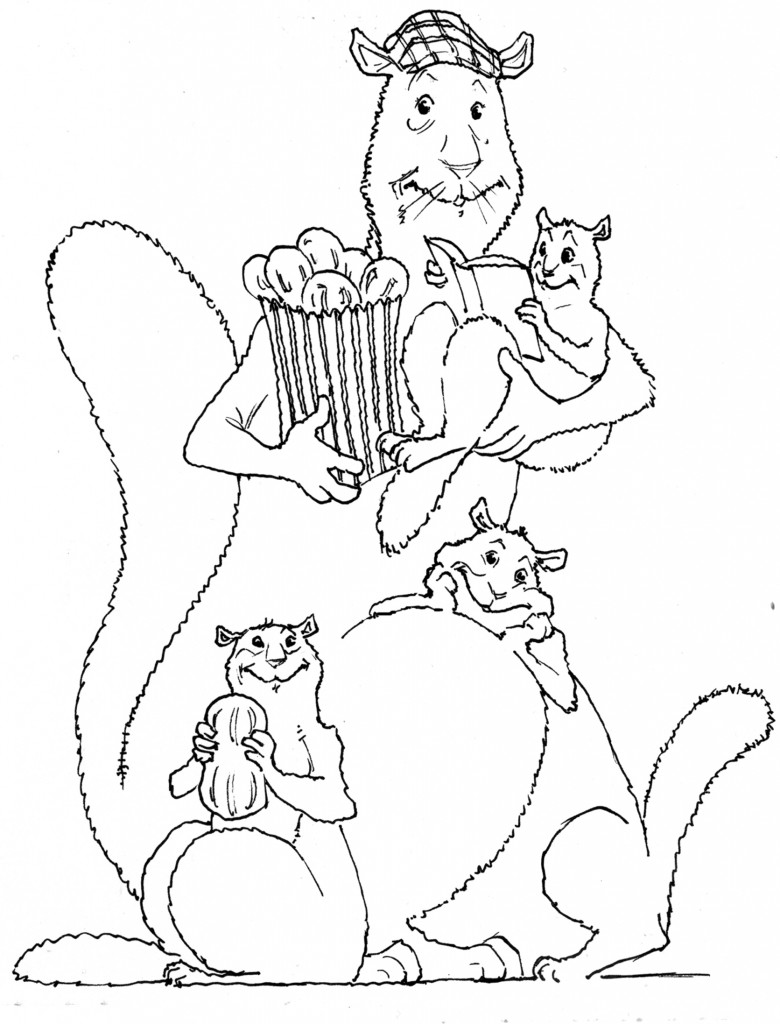
April: Poetry, Earth Day, and April Pulley Sayre
April Pulley Sayre, a gift to the children’s literature community, passed away recently. In honor of her and her incredible legacy of picture books, I’m sharing a previous post. Look at all the ways you can use her books to teach in the most engaging ways!
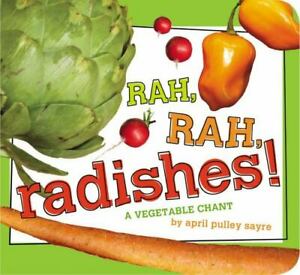
I had the pleasure of speaking at an early education conference where our theme was literacy and science. I brought stacks of books that tie into STEM (Science, Technology, Engineering, Mathematics) or STEAM (add Art) to share. Rather than just lecture all day, I led a session of “speed-dating” books: we’d spend a few minutes skimming a book and brainstorming ways to use it with students, share our ideas with the group, and pass the book along. This way, we had time to get our hands on over a dozen books and walk away with practical classroom applications. I was so inspired by the fantastic ideas the teachers generated! Here are a few ideas we came up with after reading Rah,Rah, Radishes! A Vegetable Chant by April Pulley Sayre:
Bring in vegetables found in the book. Sort the vegetables by color and by size.
Classify and sort vegetables by the parts we eat: root vegetables, leaves, etc. Read Tops and Bottoms by Janet Stevens as a tie-in text and talk about which vegetables would be “tops” or “bottoms” according to Hare.
Predict which vegetables will sink or float. Test predictions in a tub of water. Wash the vegetables and talk about textures.
Use the vegetables to make prints.
Compare and contrast with fruits.
Weigh and measure the vegetables. Use a vegetable as a measuring tool.
Take photos of vegetables and label them. Reread the book and have students hold up the corresponding photos.
Make a chart or a Venn diagram with the terms “raw” and “cooked”. Try some vegetables both ways and chart our preferences.
See what other vegetables besides potatoes can be delicious mashed (great for little ones to do the mashing!)
Bring in potatoes with “eyes” sprouting and bring in vegetable seeds. Compare seeds and sprouts, then plant!
Make an edible collage with vegetables.
Practice patterning skills like ABAB, etc. with bite-size veggies and eat when done.
Plan a field trip to a farmer’s market or invite a farmer to come to the classroom for more vegetable experiences.
If you’re interested in the list of science books I shared, please email me at kristenremenar AT gmail DOT com. If you like Rah, Rah, Radishes! A Vegetable Chant, be sure to check out Go, Go, Grapes! A Fruit Chant and Let’s Go Nuts! Seeds We Eat also by April Pulley Sayre. Hooray for early science!
Read More“The Capybaras” and the Message of Dr. Martin Luther King, Jr.
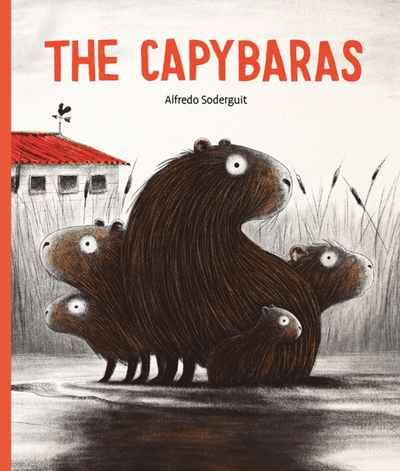
This is my new favorite book, The Capybaras by Alfredo Soderguit. It’s a wonderful read anytime but it’s especially poignant to share in January when we celebrate Martin Luther King Jr. Day. Soderguit beautifully shares one of Martin Luther King Jr.’s beliefs that we are all part of one community and all are worthy. The simplicity of the text and the art communicates in ways that draw us in for discussion.
This book works with students of any age. The language is simple enough for preschoolers but the message makes it shareable for discussion even with middle school and high school kids.
So read the book aloud all the way through without interruption with students first. Then play the video with Pious Ali, a City Councilor in Portland, Maine, sharing the book. His invitations to discussion are wonderful. As teachers of tomorrow’s leaders, may we create communities in which our diversity is seen as the gift it truly is.
Loving Kindness For Us All
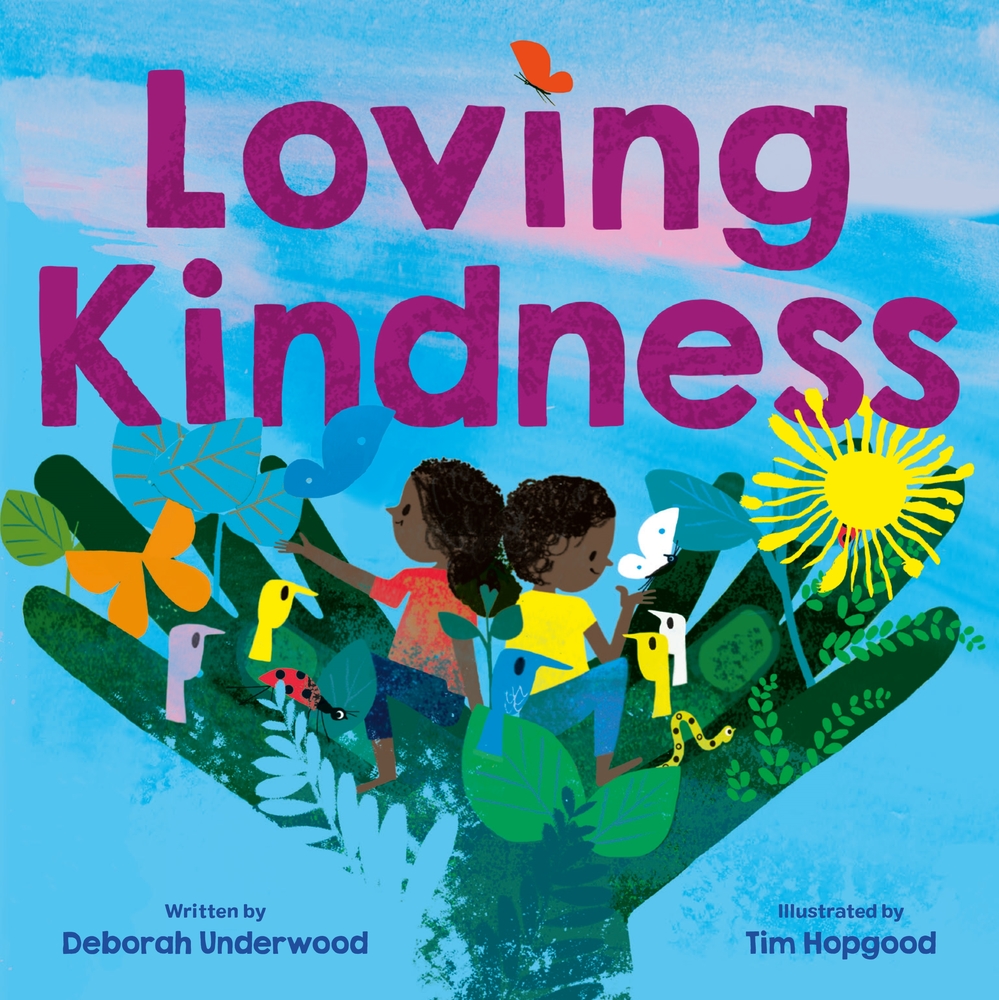
Loving Kindness written by Deborah Underwood and illustrated by Tim Hopgood is the perfect book for December. No matter what the faith of your students, this book shares a message we all need to hear.
“You are beautiful just as you are. You are loved, and you love.” We see a sweet baby who grows and is connected to the big sister, who is loved and who loves. We see the animals who are connected to these humans, also loved. We see that everyone feels the sun’s warmth and admires the moon, everyone is loved and loves.
There’s also the message that we all make mistakes, and it’s okay because that’s how we learn. Take inspiration from Tim Hopgood’s beautiful art that includes speckles of paint. Using brushes and sponges, students can paint themselves doing something they learned that was once hard to do. Unintended droplets add to the beauty of their work.
I wish you all a happy 2022 filled with Loving Kindness.
Read MorePlay It! “Ten Rules of Being a Superhero”
Twice during my years as a classroom teacher I had students that weren’t allowed to participate in Halloween activities for religious reasons. To keep the fun of dressing up without creating difficulties for any of your students, read Ten Rules of Being a Superhero by Deb Pilutti and become superheroes!

Captain Magma and Lava Boy show us the rules with bright, captivating art and with short sentences to support younger readers. Big ideas like courage, integrity, and loyalty are introduced in kid-friendly ways, and there are good giggles, too. For example, Rule Number 2: “Saving the day is messy.” As Lava Boy cleans up the playroom ( with Captain Magma holding the dustpan), he adds, “Moms don’t understand Rule Number 2.”
There’s a fantastic, free discussion and activity guide (written by Superteacher Debbie Gonzales) that you can print from debpilutti.com. You’ll find fun games and a story sequencing activity that nails that Key Ideas & Details reading standard. I think Ten Rules of Being a Superhero makes a wonderful discussion and writing prompt. What are the qualities of a superhero? Who can be one? Since many kids are thinking about costumes this season, what about making superhero gear? Towels and blankets from the thrift store (thoroughly washed) can be made into capes. Donated t-shirts or paper grocery bags can be decorated with paints and markers. Thin craft foam can be used to make masks, wrist bands, and other superhero gear.
Once everyone is looking super, play the book! Act out the rules or write rules as a class for kids to act out. I hope you are having a happy school year!
Read MoreYour Name is a Song

This is the book you need to start your school year.
A little girl is upset because her teacher and classmates not only can’t pronounce her name, they seem to think it isn’t important to say it correctly. When the little girl goes home upset, her mother tells her that her name is a song. So the girl goes back to school and sings her name, sings everyone’s name.
It is important to say names correctly. Everyone’s name.
I looooove the pronunciation key that comes with every name. We learn how to pronounce Ta’jae (TAH-jay) as well as Bob (BAWB). And if we can’t pronounce it correctly on the first try, we learn it – even sing it! – until we get it right.
You can listen to the author, Jamilah Thompkins-Bigelow read her book aloud here:
Try Food as a Way Into Reading
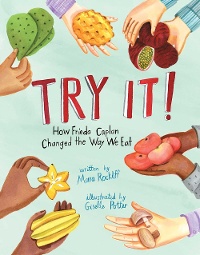
Learning is best done through experience, and food is definitely a way into learning for many of us. To tie reading in with some cool hands-on (and mouths-on) experiences, grab this biography, Try It! How Frieda Caplan Changed the Way We Eat written by Mara Rockliff and illustrated by Giselle Potter.
Apples, bananas, tomatoes, potatoes, these were almost the only things that Frieda Caplan saw when she went to her produce market. But Frieda wanted to try something different.
She brought mushrooms to sell. Everyone thought they were weird.
Until they tried them. Suddenly everyone wanted mushrooms. People even dubbed her the “Mushroom Queen”.
But she wanted more than just mushrooms.
She tried kiwi, jicama, sugar snap peas, cherimoya, champagne grapes. Red bananas, baby corn, star fruit! All kinds of new foods! She brought them all to her produce market.
And people tried them. And liked them!
A master teacher, Ed Spicer, taught his first graders that learning is all about trying. He encouraged his students to celebrate trying something new, even if they weren’t successful at first, even if they didn’t like it – that in itself is learning. You can create really memorable learning experiences by reading Try It! How Frieda Caplan Changed the Way We Eat and talking about new food.
Read this book with your kids/students/campers and talk about foods that seemed weird before you tried them. Are there foods they didn’t like before but now they do? You can make charts together of interesting foods and kids can put their names in the columns of “Yes, I like it” or “No, I don’t like it” or “I don’t know – I haven’t tried it yet”. If you have food magazines, kids can cut out foods they like and foods they want to try. Model for them, if kids start saying something is gross, that you used to think a certain food was gross but that part of growing up is that your tastes develop. Tell them about foods you used to think were weird that you now enjoy.
If you’re working with your own children or with children you know don’t have any fruit/vegetable allergies, you can bring in something like star fruit to try. I have researched allergies and it turns out for almost every food, someone is allergic to it. (Check out verywellhealthy.com – I never knew some kids aren’t bluffing about being allergic to broccoli!) To play it safe with a large group of kids, pick a cooked fruit, like applesauce. (Still, avoid anything with strawberries.) Do you think green applesauce is weird? What about pear sauce? Weird food is only weird until you try it!
Read More“We Shall Overcome”
Music can reach us in a way that nothing else can. During February – and every month – We Shall Overcome: The Story of a Song written by Debbie Levy and illustrated by Vanessa Brantley-Newton is a cross-curricular book you can use to teach American history and social justice.
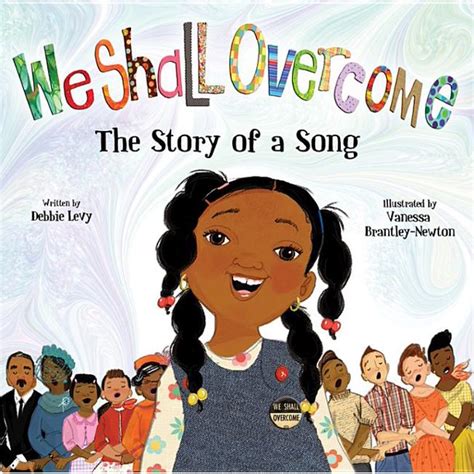
The song, “We Shall Overcome” has its roots in the time of slavery in America. Its impact has lasted for over a century and has inspired change-makers around the world. The lyrics are interspersed through the book, along with gorgeous art showing moments in history when the song was sung.
Classroom teachers, music teachers, parents, and all those who work with children, you need this book. With your students, you can talk about what the lyrics of the song mean and why this song was and is important. The last illustrated page reminds us that the work for equality is not done. We need to raise our voices and declare that the barriers against justice will be overcome. Sharing books like We Shall Overcome: The Story of a Song will teach our children that they are a part of the change for good, too.
Play the Book!
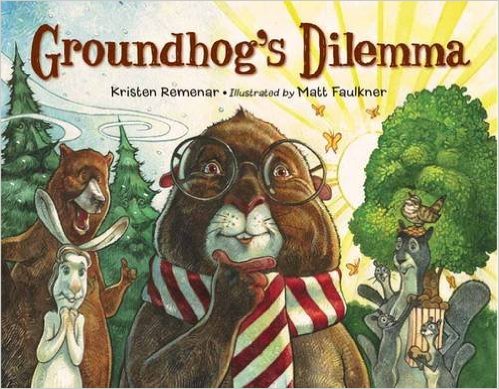
Oh, 2021, we waited all through 2020 for you and frankly, you’re not off to the start we’d hoped for. We’re exhausted in so many ways. We still need to show up for our little ones. We need a bit of lightheartedness. “Playing the book” is a fun way to connect while it helps your child deepen their understanding of a story.
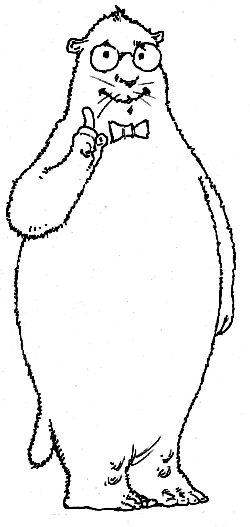
Groundhog and all of his friends are ready to be printed, colored, cut out, and played with!

When a child retells a story, they are showing how much they understand. They are moving from just listening to a book to making connections.
Playing the book lets your child to go beyond retelling by extending the story with their own imagination. Use this link to print out Groundhog and all his friends (or click on the cover of my book in the upper right-hand corner of this screen for puppets and more free fun stuff to do!) Give the characters funny voices when they try to convince Groundhog to make Spring come early or to keep Winter lasting longer. Give the characters new adventures. Take time to play. And may this year bring us all more joy.
Read MoreReading an “Again, again!” book in a new way
Happy Almost-the-End-of-2020! I think this year has been most challenging for those living with or working with small children. How do you keep them enticed if you can’t get new books from the library or from school? How do you keep yourself from going nuts if you’re tired of rereading the same books? Here’s how.
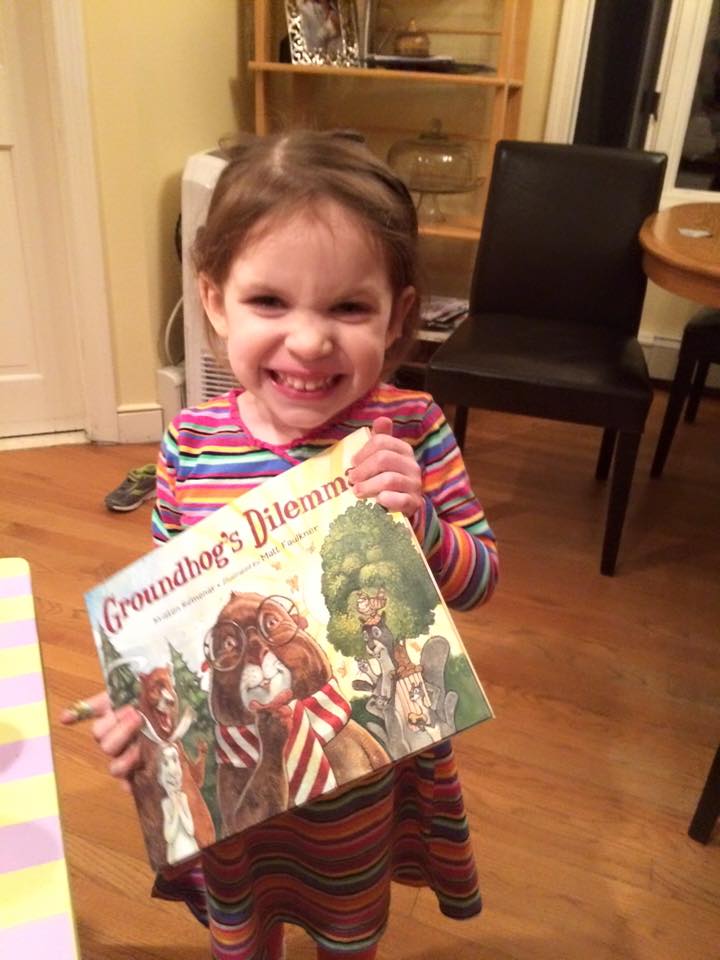
Ask your child, “What do you notice when you look at the cover of this book?” It’s really interesting to hear the details kids notice that we adults may not, the details the illustrator intentionally puts in.
“I see faces in the trees!”
“I see them now, too! Do you notice anything else?”
“The trees have snow on this side and the tree over here doesn’t have snow. So that’s winter and that’s not winter.”
“I wonder why the illustrator drew the trees that way. “
You can talk about what you see until your child is done reading the picture and wants to hear the words. The pictures often give information that the words don’t. Reading pictures is a big part of learning to read words.
This technique of letting kids lead the reading was a big shift for me as a teacher/librarian. I’m eager to get to the words. I’ve often told kids what I want them to learn from the book, trying to pour in knowledge. Lifelong learners are gatherers of knowledge. We can put kids in charge of pulling in meaning first.
Even if it’s a book you’ve read a dozen times, encourage your child to take the lead. They can tell you what they see and show you how their minds are making meaning. You may see the familiar book in a new way when your child says, “Again, again!”
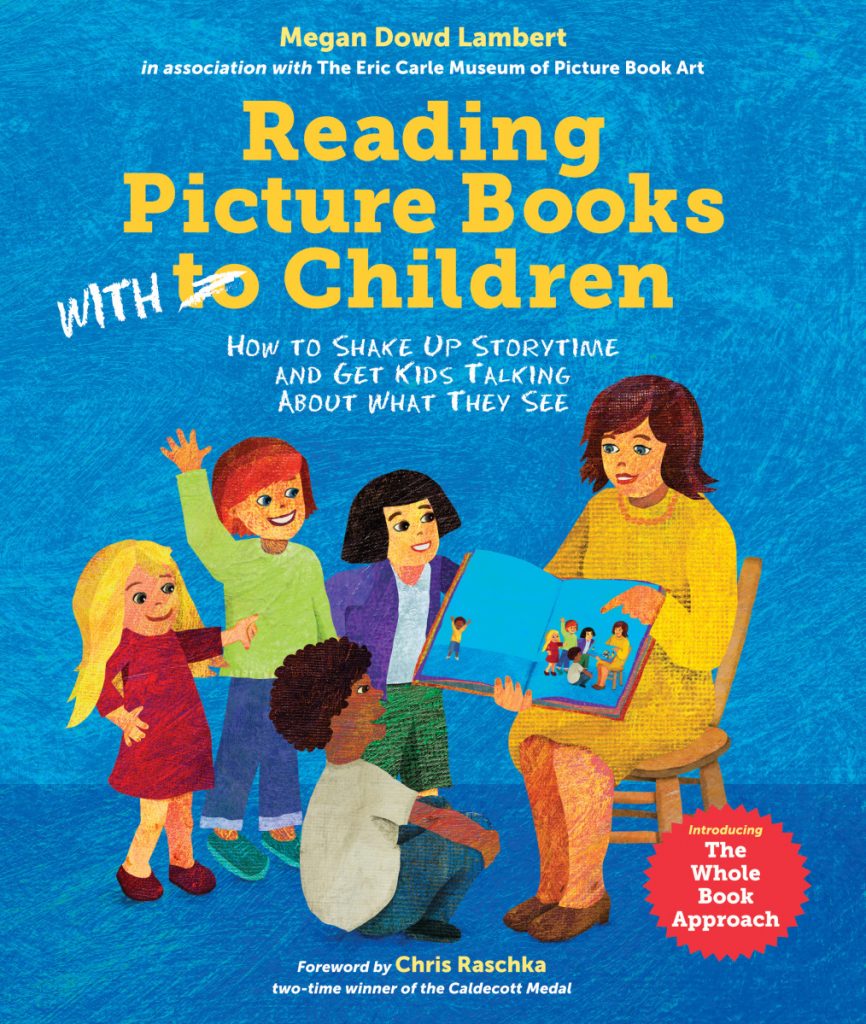
This Whole Book Approach is wonderfully taught by Megan Dowd Lambert in her book, “Reading Picture Books With Children: How to Shake Up Storytime and Get Kids Talking About What They See”. I highly recommend it!
Read MoreIt’s important: “Let’s Talk About Race”

Talking about race is hard for me, but that doesn’t let me off the hook. Racism isn’t either/or, as in I don’t shout hateful slurs therefore I’m not racist. I’m racist because I’d rather hide any prejudice I have from growing up as a white, middle-class, suburban female in America than have important conversations where I might feel uncomfortable. My silence won’t help our kids. So let’s talk about it.
Let’s Talk About Race was written by Julius Lester and illustrated by Karen Barbour. Lester, who sadly died in 2018, wrote, “I am a story. So are you. So is everyone.” He wanted kids to know that being African-American was an important part of his story, not the entirety of it. He wanted to engage kids in conversations to see our differences and our commonalities. “What is your favorite food, your religion, your favorite color, your nationality? All of these things are a part of our stories.” But, he reminds us all, “…some stories are true. Some are not. Those who say ‘MY RACE IS BETTER THAN YOUR RACE’ are telling a story that is not true.”
After you read Let’s Talk About Race with your kids, talk about race! Open up a safe conversation where students can share and ask questions. Work hard not to deny experiences, and challenge with compassion any statements that make others “less than.” And talk about all the other wonderful parts of our stories, from favorite foods to hair color to pet peeves. You can make a questionnaire based on all the elements Lester talks about for kids to answer about themselves. Then, kids can find someone who had the same answer on their list. When we help our children talk about race and equality, we help build a stronger, kinder world.
Read MoreEasy choice: GROUNDHOG’S DILEMMA!

In Michigan, the only predictable thing about the weather is its unpredictability, and I bet it’s like that where you live, too. Weather makes life so hard for Groundhog in Groundhog’s Dilemma – my book!
Half of Groundhog’s friends want him to predict an early spring, and the other half want a longer winter. Groundhog wants to please everyone, so when February 2nd comes, Groundhog has a dilemma: to see or not to see his shadow?
I have free printable activities for you! Just click on the book cover on the right side of this page. You can use the fun facts sheet for informational reading and as a springboard for animal research projects. Because the characters in this book have strong opinions and are trying to persuade our hero Groundhog (who is not immune to the lures of membership on a team or blueberry pie), use Groundhog’s Dilemma as a prompt for writing an opinion piece. Students can write a persuasive letter to Groundhog. Kids who send letters to Groundhog via my email will receive responses!
February 2nd is my birthday so Groundhog Day has always been my favorite holiday. I hope you enjoy it as much as these kiddos do!
Less “tizzy-busy”, more joy!

Pout-Pout Fish fans, this is the just-right book for the holiday season! The Not Very Merry Pout-Pout Fish is a wonderful addition to The Pout-Pout Fish series.
Mr. Fish feels caught up in the “tizzy-busy” rush to find the perfect gifts.
“… a gift should have meaning,
Plus a bit of bling-zing,
So I’ll shop till I drop
For each just-right thing!”
The repetition of these lines not only supports our early readers, it completely captures the overwhelmed feeling many of us get. When Mr. Fish has shopped until he’s plopped, Miss Shimmer helps him make wonderful gifts. Most importantly, they enjoy their time with their fishy friends.
Let’s scale back this season. Share The Not Very Merry Pout-Pout Fish with your kiddos, and talk about what you can make and do instead of buy. I wish you all oceans of joy and contentment this year! Find more fishy fun at www.poutpoutfish.com.
Read MoreHow-To Poems and My Love of Hedgehogs
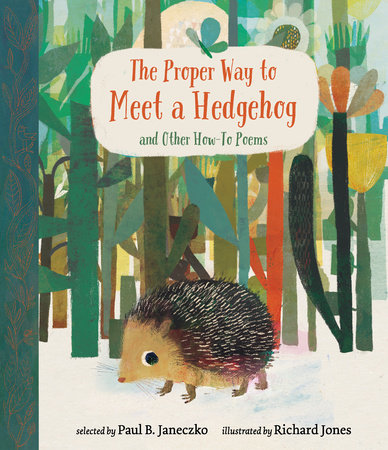
How-to poems are an easy introduction to poetry, to nonfiction, and to writing what you know. This book of poems selected by Paul B. Janeczko and illustrated by Richard Jones has such a wide range of topics that all your students will find at least one poem that they love. My favorites are “Toasting Marshmallows” by Marilyn Singer and “How to Scare Monsters” by Rebecca Kai Dotlich.
This book was given to me by fellow librarian Linda Pannuto because my storytimes always began and ended with Barb the Hedgehog. (She can curl up into a ball when she is shy.) And look at what Barb and I now have! Honey Hedgehog Cookies from Trader Joe’s AND a hedgehog purse! I’m all prickly with excitement!
Share “The Proper Way to Meet a Hedgehog and Other How-To Poems” and have students write an informational poem about what they know how to do. Share Honey Hedgehog Cookies while they write and get your own Folkmanis hedgehog puppet to share. Hands off the purse, though. That beauty is mine.
(Shout out to Lisa Wheeler and Janie Bynum for their book, “Porcupining: A Prickly Love Story” from which I stole Barb’s name. You two are sharp.)

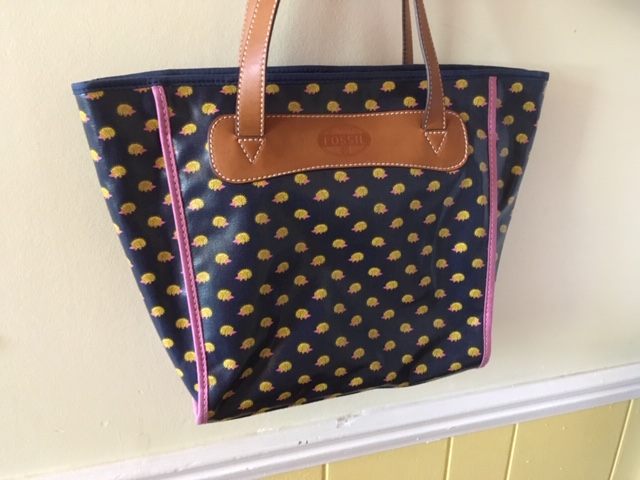
Start your new year off with compassion
This is a post I’ve shared before but I think it’s more important than ever to make your classroom a place of acceptance and compassion from day one.
It’s September, the start of a new school year. I have no apples for you teachers, but I do have the perfect back-to-school picture book to teach empathy and point of view: I’m New Here by Anne Sibley O’Brien.
Maria, Jin, and Fatimah are new to their schools and to the United States. Through their stories, we get a glimpse of what it’s like to hear a new language, to see a new alphabet, and to try to pick up a new set of classroom expectations. “Back home… I knew just what to do.” All of your students can relate to the unsettled feeling of a first day in a new classroom. With I’m New Here, you can expand upon that feeling to help your students empathize with people who are new to our country. I love that Anne Sibley O’Brien not only shows what it’s like to be an immigrant, but how we all learn from each other. On one page, O’Brien writes from Jin’s point of view, “I am learning from others. And they are learning from me.” Jin asks a little boy, “How to spell cloud?” The boy responds, “C-L-O-U-D.” Jin holds up a piece of paper with Korean characters on it. “This is cloud in Korean.” “Cool.”
Michelle A., a gifted kindergarten teacher of English as a Second Language students and a remarkable friend, told me about Step Inside thinking. After you’ve read through the book, ask your students to “step inside” a character and imagine that they are Maria, Jin, or Fatimah. Students can write and draw from the perspective of the character, describing what was a challenge and what helped. You can turn this book into a readers’ theater script for students to perform, or have students take on the roles in an impromptu performance as you reread the book. As a class, you can talk and write about what you all can do to help a new student feel welcome. Whether or not you gain a new student during the year, all of your students will gain a wider, more empathetic perspective from I’m New Here.
Read More“Grandma Heaven” and “Grandpa Heaven”

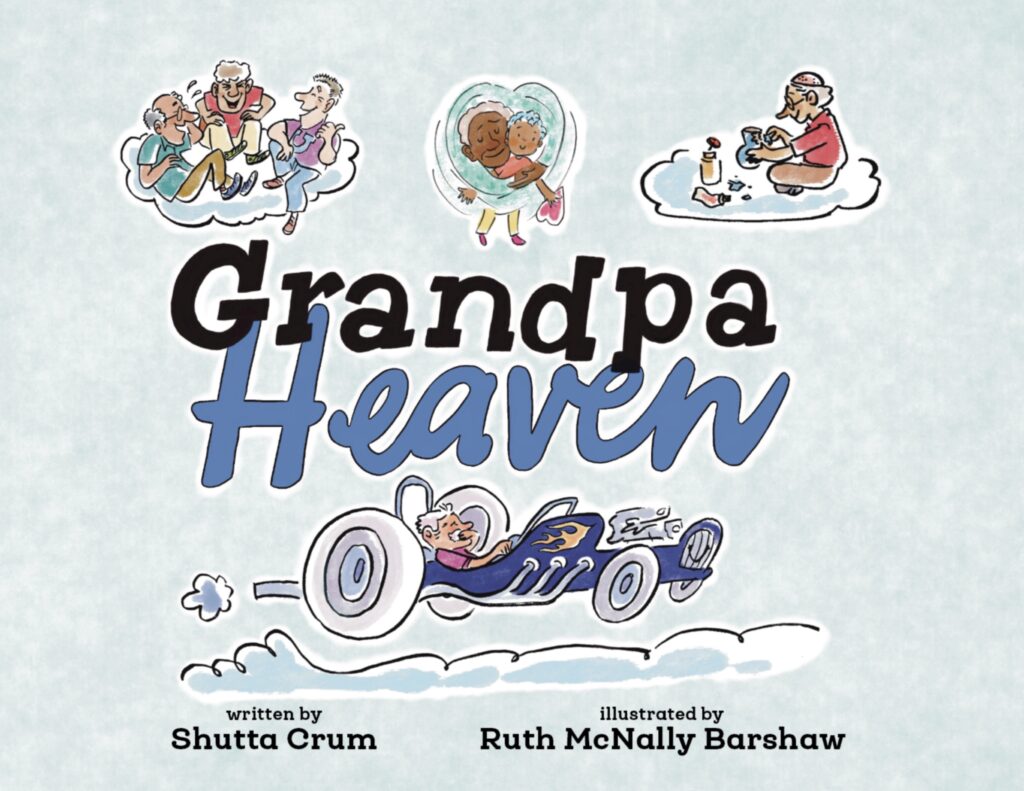
Shutta Crum and Ruth McNally Barshaw are two of my most favorite people in the kid lit world. They have two new books out, “Grandma Heaven” and “Grandpa Heaven” that sweetly feature my own parents as two of the people enjoying the afterlife.
Is Heaven a fun-filled place of laughter, companionship, and love? Who knows. Perhaps it’s
simply a state of the universal/eternal mind. Regardless, Shutta Crum knows that here in this
corporeal world there are young worriers who’ve suddenly lost a beloved grandparent, and those
bereft children need to be consoled. Shutta began working on Grandma Heaven and Grandpa
Heaven years ago when her four-year-old grandchild asked, “Are you going to die, Grammy?”
Shutta reassured her granddaughter that that was not going to happen for a long time. But the
child’s question sparked the idea for these two books about grandparents having a great time in
Heaven. The grandparents drive snazzy cars in Heaven, study prehistoric animals, have pets,
bake, read, knit, bowl, tinker with broken things, and zip in on zip-lines. But the most important
job of a grandparent in the afterlife is watching over all the grandchildren of the world and
sending the memory of a hug when it is needed. Importantly, these two books are non-religious
and multicultural. Heaven in Grandma Heaven and Grandpa Heaven is populated by
grandparents from around the world so that all children can rest assured that their grandparents’
love never dies.
Grandma Heaven and Grandpa Heaven (published by Lawley Books, 2023) can be found online
wherever books are sold. Also, ask for them at your local bookstore, or to be purchased by your
local library. Paperback editions available: Sept. 28, 2023. Spanish editions: January 2024.





